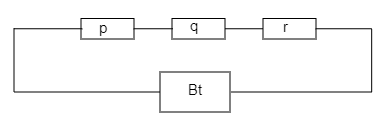
In series combination of resistances:
(A) p.d. is same across each resistance
(B) total resistance is reduced
(C) current is same in each resistance
(D) all above are true
Answer
218.7k+ views
Hint In order to solve this question, the simple rough diagram is drawn then the rough diagram of series combination of the resistance shows which statement is the correct answer. When the resistance is connected in series there is only one wire used.
Complete step by step solution
Assume that the $p$, $q$ and $r$ are the three resistance which are connected in series.

Let assume that the current through the wire is $i$ and the potential difference through the wire is $V$, one end of the wire is connected to the positive terminal of the battery and the other end of the wire is connected in the negative terminal of the battery in between the wire three resistance are connected in series.
If the current crosses the resistance $p$, then the voltage is reduced by $ip$, so the resistance $q$ will get the less voltage than the resistance $p$ and it will again reduce the voltage by $iq$, so the resistance $r$ will get the less voltage than the resistance $q$. So, the potential difference across each resistance is different. The equivalent resistance in series is the sum of all the resistance and it will always be larger than the largest resistance. So, the current flowing the wire is the same through all the three resistance.
Hence, the option (C) is the correct answer.
Note To solve this problem, we have to know that the resistor in series will have the same current and the resistance in series will not have the same voltage. It will be given by the law of the ohm’s law. In ohm’s law, the voltage is directly proportional to the resistance when the resistance is in series.
Complete step by step solution
Assume that the $p$, $q$ and $r$ are the three resistance which are connected in series.

Let assume that the current through the wire is $i$ and the potential difference through the wire is $V$, one end of the wire is connected to the positive terminal of the battery and the other end of the wire is connected in the negative terminal of the battery in between the wire three resistance are connected in series.
If the current crosses the resistance $p$, then the voltage is reduced by $ip$, so the resistance $q$ will get the less voltage than the resistance $p$ and it will again reduce the voltage by $iq$, so the resistance $r$ will get the less voltage than the resistance $q$. So, the potential difference across each resistance is different. The equivalent resistance in series is the sum of all the resistance and it will always be larger than the largest resistance. So, the current flowing the wire is the same through all the three resistance.
Hence, the option (C) is the correct answer.
Note To solve this problem, we have to know that the resistor in series will have the same current and the resistance in series will not have the same voltage. It will be given by the law of the ohm’s law. In ohm’s law, the voltage is directly proportional to the resistance when the resistance is in series.
Recently Updated Pages
Young’s Double Slit Experiment Derivation Explained

Wheatstone Bridge Explained: Working, Formula & Uses

Chemical Properties of Hydrogen - Important Concepts for JEE Exam Preparation

JEE General Topics in Chemistry Important Concepts and Tips

JEE Atomic Structure and Chemical Bonding important Concepts and Tips

JEE Amino Acids and Peptides Important Concepts and Tips for Exam Preparation

Trending doubts
JEE Main 2026: Application Form Open, Exam Dates, Syllabus, Eligibility & Question Papers

Derivation of Equation of Trajectory Explained for Students

Hybridisation in Chemistry – Concept, Types & Applications

Understanding the Angle of Deviation in a Prism

Understanding Collisions: Types and Examples for Students

Understanding Atomic Structure for Beginners

Other Pages
JEE Advanced Marks vs Ranks 2025: Understanding Category-wise Qualifying Marks and Previous Year Cut-offs

How to Convert a Galvanometer into an Ammeter or Voltmeter

Understanding Centrifugal Force in Physics

Ideal and Non-Ideal Solutions Explained for Class 12 Chemistry

Degree of Dissociation: Meaning, Formula, Calculation & Uses

Understanding Electromagnetic Waves and Their Importance




